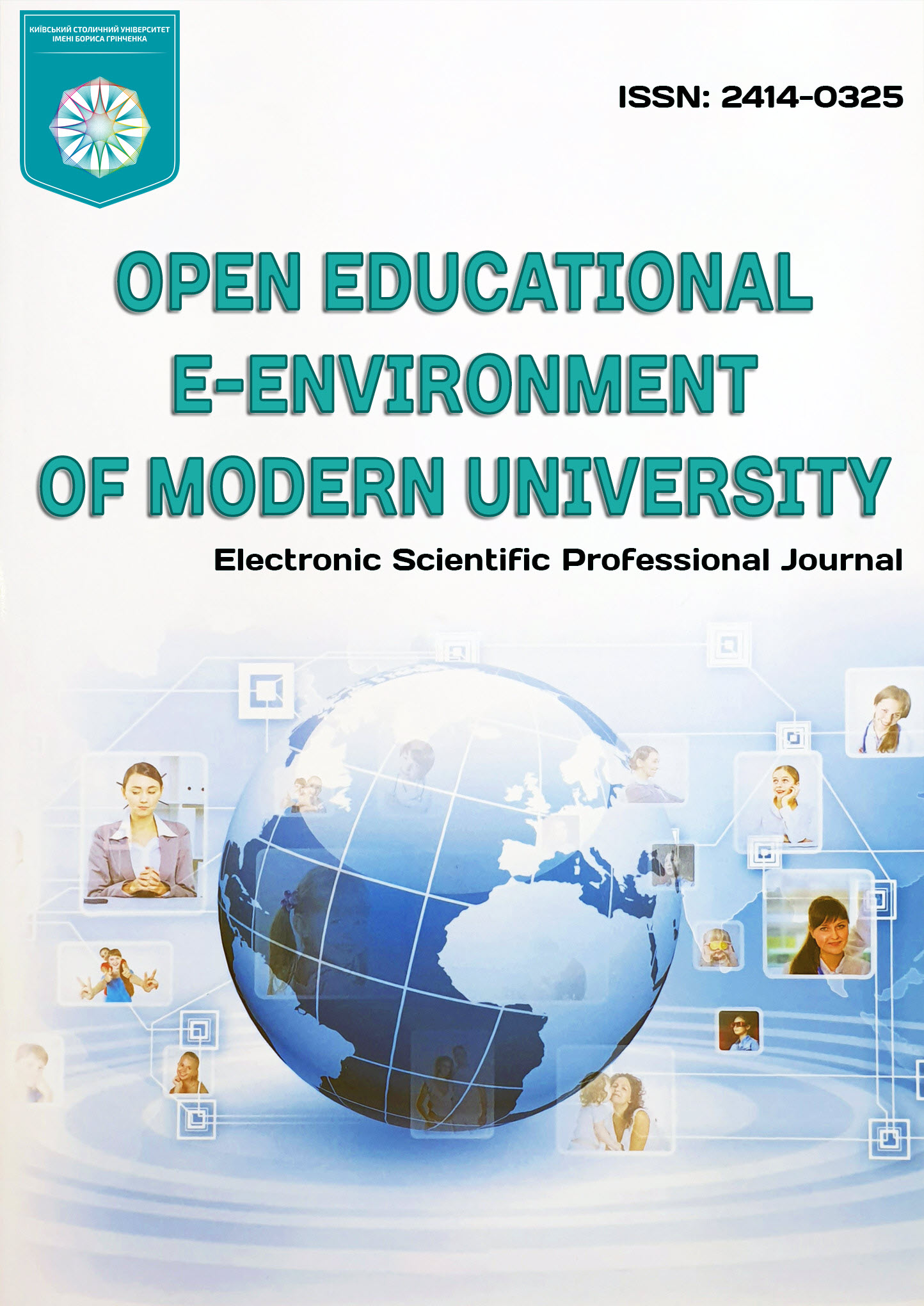ВИКОРИСТАННЯ ШТУЧНОГО ІНТЕЛЕКТУ В ЗАКЛАДІ ДОШКІЛЬНОЇ ОСВІТИ
DOI:
https://doi.org/10.28925/2414-0325.2024.1614Ключові слова:
дошкільна освіта, штучний інтелект, освітнє середовище, навчальна взаємодіяАнотація
Визначальної ролі у різних сферах життя, включаючи освіту, набуває технологія штучного інтелекту. Сучасні дошкільні заклади стикаються з потребою адаптуватися до вимог сучасного світу, де технології є обов’язковою складовою. У статті визначено нормативно-правові засади використання технологій штучного інтелекту у сфері освіти. На основі вивчення та систематизації результатів наукових досліджень виявлено напрями та способи використання штучного інтелекту в освітній галузі. Обґрунтовано з авторських позицій науково-педагогічні орієнтири використання генеративних моделей штучного інтелекту в закладі дошкільної освіти. Представлено сучасні можливості використання технології штучного інтелекту в освітньому процесі закладу дошкільної освіти, зокрема, особливості використання штучного інтелекту батьками дітей дошкільного віку. Також, запропоновано практичні аспекти застосування штучного інтелекту фахівцями в закладі дошкільної освіти, зокрема, ChatGPT, Quillbot, Google Gemini, Vocal Remover. Підкреслено важливість правильного підходу до впровадження штучного інтелекту в освітній процес, щоб забезпечити ефективність та безпеку для дітей. Узагальнено результати опитувань батьків дошкільнят та фахівців закладу дошкільної освіти щодо потенціалу використання штучного інтелекту в дошкільній освіті для розвитку дітей, що вимагає ретельного підходу та співпраці між педагогами, батьками та адміністрацією закладу дошкільної освіти. Використання штучного інтелекту в дошкільній освіті є перспективним напрямком, що може забезпечити підтримку фахівців закладу дошкільної освіти, зробити процес навчання цікавішим для дітей та сприяти їхньому інтелектуальному розвитку. Тому дослідження та розробка практик використання штучного інтелекту в дошкільній освіті є важливою складовою ефективного впровадження цих технологій.
Завантаження
Посилання
Gwira, C. (2023). 10 Best AI Logo Generators in 2023 (Most are Free). Elegant Themes, July.
https://www.elegantthemes.com/blog/design/best-ai-logo-generators.
Osadchyi, V., Osadcha, K., & Eremeev, V. (2017). The model of the intelligence system for the analysis of qualifications frameworks of European Countries. International Journal of Computing, 16(3), 133-142.
https://doi.org/10.47839/ijc.16.3.896.
Osadcha, K. & Osadcha, M. (2023). Generative Artificial Intelligence vs humans in the process of creating corporate identity elements”, ITLT, Vol. 98, №6, 212-230. Dec. doi: 10.33407/itlt.v98i6.5494.
Morze, N., Buinytska, O. & Varchenko-Trotsenko, L. (2017). Use of bot-technologies for educational communication at the university. Effective Development of Teachers’ Skills in the Area of ICT and E-learning, E-learning, Vol. 9, 239-248. https://open.icm.edu.pl/server/api/core/bitstreams/db58704e-f8df-4d34-8c15-b60aaa5b6130/content
Morze, N., Varchenko-Trotsenko, L., Terletska, T., & Smyrnova-Trybulska, E. (2023). Artificial intelligence in the role of elementary school teacher's assistant. Electronic Scientific Professional Journal «Open Educational E-Environment of Modern University», #15, 97-115.
https://doi.org/10.28925/2414-0325.2023.158 (іn Ukrainian).
Directorate-General for Education (2022). Ethical guidelines on the use of artificial intelligence (AI) and data in teaching and learning for educators. Publications Office of the European Union. https://data.europa.eu/doi/10.2766/153756.
Mar'jenko, M., & Kovalenko, V. (2023). Artificial intelligence and open science in education. Physical and mathematical education, #38(1), 48-53. https://doi.org/10.31110/2413-1571-2023-038-1-007 (іn Ukrainian).
Striuk, O. & Kondratenko, Y. (2021). Generative Adversarial Neural Networks and Deep Learning: Successful Cases and Advanced Approaches. International Journal of Computing, 20(3), 339-349. https://computingonline.net/files/journals/1/archieve/IJC_2021_20_3_03.pdf.
Williamson, B. & Eynon, R. (2020). Historical threads, missing links, and future directions in AI in education. Learning, Media and Technology, 45(3) 223-235. https://doi.org/10.1080/17439884.2020.1798995.
Kiselova, O., Prytomanova, O. & Hart L. (2021). Application of the theory of optimal partitioning of sets to solving problems of artificial intelligence and pattern recognition. System research and information technologies, № 4. http://journal.iasa.kpi.ua/article/view/252300/249601 (іn Ukrainian).
On the approval of the Concept of the development of artificial intelligence in Ukraine. The official portal of the Verkhovna Rada of Ukraine (2021). https://zakon.rada.gov.ua/laws/show/1556-2020-%D1%80#Text (іn Ukrainian).
Fengchun, M., Wayne, H., Ronghuai, H. & Hui, Z. (2021). AI and education: guidance for policy-makers. UNESCO. https://unesdoc.unesco.org/ark:/48223/pf0000376709/PDF/376709eng.pdf.multi.
Miao, F. (2023). A proposed AI competency framework for teachers to test initial. https://www.linkedin.com/posts/fengchun-miao-5b999077_a-proposed-ai-competency-framework-for-teachers-activity-7096128261931327488-K_pM.
AI Pioneers. (2022). Active Citizens Partnership. https://activecitizens.eu/portfolio/ai-pioneers/.
Artificial Intelligence Act: MEPs adopt landmark law. (2024). European Parliament. https://www.europarl.europa.eu/news/en/press-room/20240308IPR19015/artificial-intelligence-act-meps-adopt-landmark-law.
Kostenko, O. (2022). Analysis of national strategies for the development of artificial intelligence. Information and law, №2(41), 58-69. http://il.ippi.org.ua/article/view/270365 (іn Ukrainian).
Lawton, G. (2023). What is Generative AI? Everything You Need to Know. TechTarget. https://www.techtarget.com/searchenterpriseai/definition/generative-AI.
Alto, V. (2023). Modern Generative AI with ChatGPT and OpenAI Models: Leverage the Capabilities of OpenAI's LLM for Productivity and Innovation with GPT3 and GPT4. Birmingham, United Kingdom: Packt Publishing, Limited.
Sharov, S. (2023). The current state of artificial intelligence development and directions of its use. Ukrainian studies in the European context, №6. http://obrii.org.ua/usec/storage/article/Sharov_2023_136.pdf (іn Ukrainian).
Vorotnykova, I. (2023). Professional development of science and mathematics teachers using artificial intelligence. The electronic scientific publication «Open educational e-environment of the modern university», 15, 18–34.
https://doi.org/10.28925/2414-0325.2023.152 (іn Ukrainian).
Moskaljuk, M., Moskaljuk, N. & Lenj, A. (2023). Artificial intelligence in institutions of higher education: advantages and disadvantages. The electronic scientific publication «Open educational e-environment of the modern university», 15, 85-96. https://doi.org/10.28925/2414-0325.2023.157 (іn Ukrainian).
Holmes, W., Bialik, M. & Fadel, C. (2019). Artificial Intelligence in Education: Promises and implications for teaching and learning. Boston. MA. Center for Curriculum Redesign.
Ortiz, S. (2023). The best AI image generators of 2023: DALL-E 2 and alternatives. ZDNet.
https://www.zdnet.com/article/best-ai-art-generator.
Pensworth, L. (2019). Internet Statistics, Trends & Data. DailyWireless. https://dailywireless.org/internet/usage-statistics/.
The Digital Divide and Educational Equity. (2018). ACT Center for Equity in Learning. https://equityinlearning.act.org/wp-content/themes/voltron/img/tech-briefs/the-digital-divide.pdf.
Molenaar, I. (2022). The concept of hybrid human-AI regulation: Exemplifying how to support young learners’ self-regulated learning. Computers and Education: Artificial Intelligence. https://doi.org/10.1016/j.caeai.2022.100070
Опубліковано
Як цитувати
Номер
Розділ
Ліцензія
Авторське право (c) 2024 Фамілярська Л.Л.

Ця робота ліцензується відповідно до Creative Commons Attribution-NonCommercial-ShareAlike 4.0 International License.













1.jpg)








